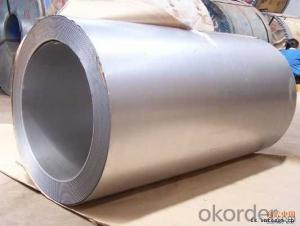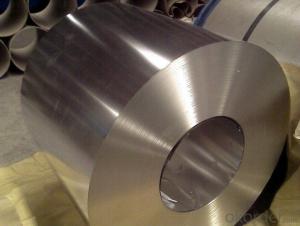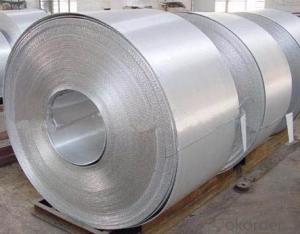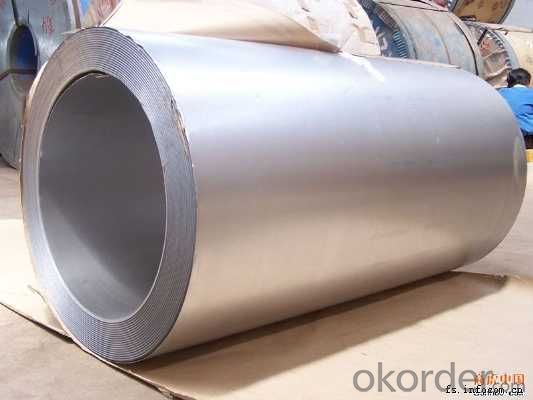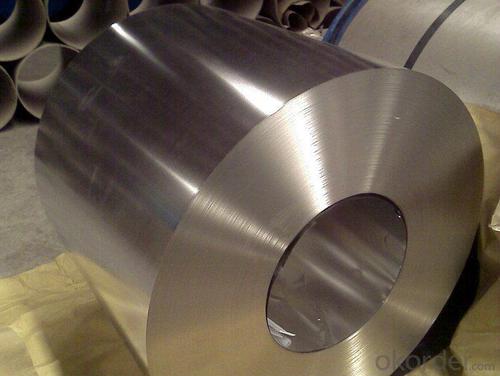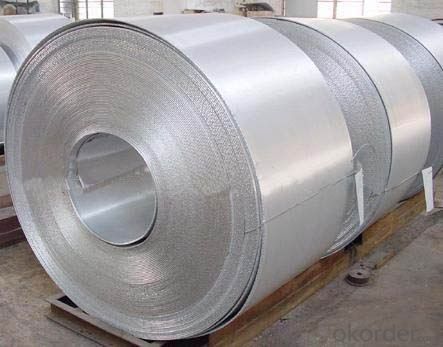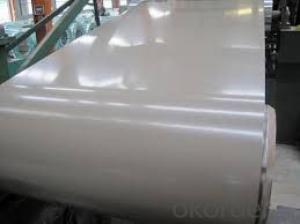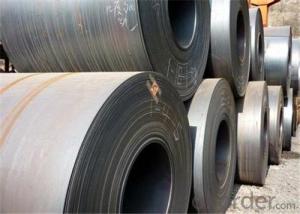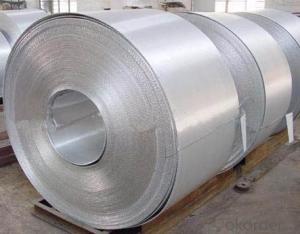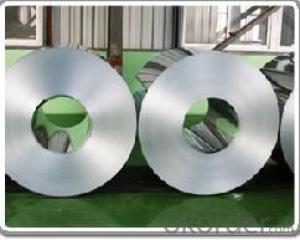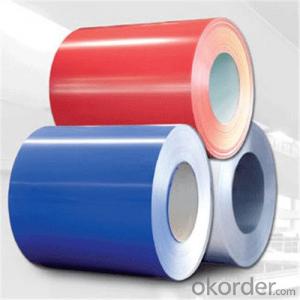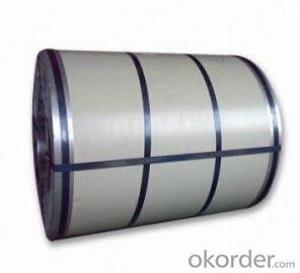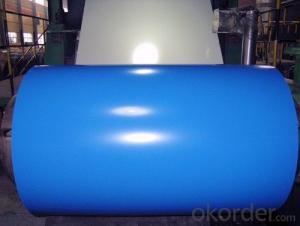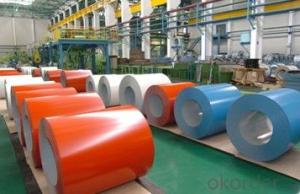Hot dipped 55% AL-ZN Coated Galvalume steel coil
- Loading Port:
- Shanghai
- Payment Terms:
- TT OR LC
- Min Order Qty:
- 25 m.t.
- Supply Capability:
- 100000 m.t./month
OKorder Service Pledge
OKorder Financial Service
You Might Also Like
Packaging & Delivery
| Packaging Detail: | Seaworthy Packing |
| Delivery Detail: | 25days |
Specifications
Galvalume steel coils
Min Yield Strength of 550MPA
Min/Regular Spangle
Zinc coating:60-600g/m2
Hot Dipped 55% Aluminum Zinc Alloy Coated Steel by the Hot-Dip Process
Hot Dip Galvalume steel coil EN 10327 JIS G3321, ASTM A792M 55% AL-ZN coated
Description:
The hot dip galvalume steel is a kind of coated steel. With the cold rolled steel of different strength and thickness as substrate, it is produced through applying Al-Zn coat on both faces by hot dip process. In its coating, Al accounts for about 55%, Si 1.6%, while the remaining is Zn. It enjoys both the physical protective feature and durability of Al and the electrochemical protective property of Zn. And its surface has bright silver color and regular embossed-like figure, which are highly decorative.
Comparison
Item | GI | GF(Zn-5%Al) | GALVA-LUME(55%Al-45%Zn) | Al |
Service Life | Fair | Fair | Good | Good |
Electrochemical Protection | Good | Good | Good | N/A |
Welding Performance | Good | Fair | Poor | Poor |
Application with Wet Concrete | Good | Poor | Very Poor | Very Poor |
Thermal Resistance | Poor | Poor | Good | Excellent |
Specifications:
Standard | EN 10327 | DX51D+AZ, DX52D+AZ, DX53D+AZ, |
EN 10326 | SS250GD+AZ, SS350GD+AZ | |
JIS G3321 | SGLCC, SGLCD, SGLCDD, SGLC 400 | |
ASTM A792M | CS type C, CS type B, DS, SS255, SS345 | |
Base Metal | Cold rolled steel coils SPCC, SPCD, SPCE, DC01, DC03, DC04, CS, DS, DDS, Q195, Q250, Q350 | |
Thickness | 0.22mm-2.0mm | |
Width | 700mm-1300mm | |
Coil ID | 508mm, 610mm | |
Zinc coating | 60g/m2-180g/m2 | |
Surface treating | chromium free passivation, chromium passivation, fingerprint resistant, oiled | |
Spangle types | regular spangle | |
Applications:
Architecture | Roofs and outside walls of civilian and industrial buildings, garage doors, fencings and window blinds |
Appliances Industry
| Outer clad sheets for washing machine, refrigerator, television, air conditioner and ventilation system, explosion-proof strip, solar water heater and appliance parts |
Auto Industry
| Muffler, heat shields of exhaust pipe and catalytic converter, auto parts & accessories under the frame, signboard in highway. |
Industrial Instruments
| Electric control cabinet, industrial refrigeration equipment, automatic vending machine |
Packaging & Delivery
| Packaging Detail: | Seaworthy Packing |
| Delivery Detail: | 25days |
Specifications
Galvalume steel coils
Min Yield Strength of 550MPA
Min/Regular Spangle
Zinc coating:60-600g/m2
Hot Dipped 55% Aluminum Zinc Alloy Coated Steel by the Hot-Dip Process
Hot Dip Galvalume steel coil EN 10327 JIS G3321, ASTM A792M 55% AL-ZN coated
Description:
The hot dip galvalume steel is a kind of coated steel. With the cold rolled steel of different strength and thickness as substrate, it is produced through applying Al-Zn coat on both faces by hot dip process. In its coating, Al accounts for about 55%, Si 1.6%, while the remaining is Zn. It enjoys both the physical protective feature and durability of Al and the electrochemical protective property of Zn. And its surface has bright silver color and regular embossed-like figure, which are highly decorative.
Comparison
Item | GI | GF(Zn-5%Al) | GALVA-LUME(55%Al-45%Zn) | Al |
Service Life | Fair | Fair | Good | Good |
Electrochemical Protection | Good | Good | Good | N/A |
Welding Performance | Good | Fair | Poor | Poor |
Application with Wet Concrete | Good | Poor | Very Poor | Very Poor |
Thermal Resistance | Poor | Poor | Good | Excellent |
Specifications:
Standard | EN 10327 | DX51D+AZ, DX52D+AZ, DX53D+AZ, |
EN 10326 | SS250GD+AZ, SS350GD+AZ | |
JIS G3321 | SGLCC, SGLCD, SGLCDD, SGLC 400 | |
ASTM A792M | CS type C, CS type B, DS, SS255, SS345 | |
Base Metal | Cold rolled steel coils SPCC, SPCD, SPCE, DC01, DC03, DC04, CS, DS, DDS, Q195, Q250, Q350 | |
Thickness | 0.22mm-2.0mm | |
Width | 700mm-1300mm | |
Coil ID | 508mm, 610mm | |
Zinc coating | 60g/m2-180g/m2 | |
Surface treating | chromium free passivation, chromium passivation, fingerprint resistant, oiled | |
Spangle types | regular spangle | |
Applications:
Architecture | Roofs and outside walls of civilian and industrial buildings, garage doors, fencings and window blinds |
Appliances Industry
| Outer clad sheets for washing machine, refrigerator, television, air conditioner and ventilation system, explosion-proof strip, solar water heater and appliance parts |
Auto Industry
| Muffler, heat shields of exhaust pipe and catalytic converter, auto parts & accessories under the frame, signboard in highway. |
Industrial Instruments
| Electric control cabinet, industrial refrigeration equipment, automatic vending machine |
- Q: I was cutting a sheet of steel with an angle grinder when suddenly the rate at which the blade was cutting slowed way down. I tried a few different things, and turned off the tool and looked at the blade. It didn't look damaged, but it definitely was not cutting as quickly. I thought either I had hit a harder section of steel (is that possible? It looked pretty uniform) or the blade had lost it's abrasive quality or something. Also, before this happened I had accidentally cut into the wooden sawhorse that was holding up the steel sheet, but I've done that before with no problem. After a short while the problem fixed itself and the rate of cutting went back to a fast normal. Anyone know why this happened?
- Sounds like the abrasive surface got blinded, coated with something that prevented the abrasive particles from touching the steel. It is possible to have vastly different hardnesses in a single piece of steel. Case hardening, carburizing, induction hardening, heat affected zone from welding, differences in work hardening, and presence of inclusions are some of the things that can create hardness variation within a single piece. But... sounds like you are working with a sheet which is unlikely to have any of these conditions. So... it was probably the grinding disk
- Q: Hello, Do I make any damage to my stainless steel sink by cleaning it with clorox? Thank you!
- Bleach Stainless Steel Sink
- Q: How are steel coils inspected for bendability using bend testers?
- Steel coils are inspected for bendability using bend testers by subjecting them to a controlled bending process. The bend tester applies a specific amount of force to the coil, gradually bending it to determine its flexibility and resistance to bending. This helps assess the quality and suitability of the steel coil for various applications, such as manufacturing processes that require bendable materials.
- Q: Steel is a mixture of Iron Carbon . So , is steel a metal or non - metal ?
- This Site Might Help You. RE: Is Steel a Metal or Non - Metal ? Steel is a mixture of Iron Carbon . So , is steel a metal or non - metal ?
- Q: Can steel coils be perforated?
- Yes, steel coils can be perforated. Perforation is the process of creating small holes or punctures in a material, and steel coils can undergo this process to achieve specific purposes such as enhancing ventilation, improving drainage, or creating decorative patterns.
- Q: Can steel coils be bent or formed into different shapes?
- Yes, steel coils can be bent or formed into different shapes. Steel coils are typically made from flat rolled steel, which is flexible and can be easily manipulated. The bending process involves applying force to the steel coil, causing it to change shape and form into various configurations. This can be achieved through different techniques such as cold bending, hot bending, or using specialized machinery like a press brake. By applying the appropriate amount of force and heat, steel coils can be bent or formed into a wide range of shapes, including curves, angles, and complex geometries. This versatility in shaping steel coils makes them highly adaptable for various applications, such as in construction, manufacturing, automotive, and many other industries.
- Q: How are steel coils used in the manufacturing of tubes?
- Steel coils are used in the manufacturing of tubes by being unwound and fed through a tube mill where they are shaped and welded together to form seamless or welded tubes.
- Q: What are the different types of steel coil grades?
- There are several different types of steel coil grades used in various industries and applications. Some of the most common steel coil grades include: 1. Carbon Steel: This is a basic type of steel that contains mostly iron and carbon. It is widely used in construction, automotive, and manufacturing industries due to its high strength and durability. 2. Stainless Steel: This type of steel contains chromium, which provides corrosion resistance and makes it suitable for applications that require resistance to oxidation and staining. It is commonly used in the food processing, chemical, and medical industries. 3. High-Strength Low-Alloy (HSLA) Steel: HSLA steel contains small amounts of alloying elements such as copper, phosphorus, niobium, and vanadium. This type of steel offers higher strength and better mechanical properties compared to carbon steel, making it suitable for structural applications. 4. Galvanized Steel: Galvanized steel is coated with a layer of zinc to protect it from corrosion. It is commonly used in outdoor applications, such as roofing, fencing, and automotive parts. 5. Electrical Steel: Also known as silicon steel, electrical steel has high magnetic permeability, low electrical conductivity, and low core loss. It is used in the production of transformers, motors, and other electrical equipment. 6. Tool Steel: Tool steel is a high-carbon steel that is specifically designed for making tools and dies. It has excellent hardness, wear resistance, and toughness, making it suitable for cutting, forming, and shaping materials. These are just a few examples of the different types of steel coil grades available. Each grade has its own unique properties and characteristics, making it suitable for specific applications in various industries.
- Q: Search the internet for 'Frost Clipper Knife'. This knife comes in either stainless or carbon steel. I have a friend who has one (stainless steel) and he is very impressed with it, but I have heard that Carbon Steel blades are better? Discuss...
- If your talking about a folding pocket knife, I think that it's basically six one way and a half dozen the other. I actually do prefer stainless for my pocket knives. I don't want to oil a knife to the degree I feel carbon requires, only to then stick it my pocket to attract dirt to the knife and oil to my pants. I'm the exact opposite on sheath knives though. I like 1095 carbon steel, plain edge sheath knives. I'll thrash on them HARD, and I rarely have major edge problems. Of course, I require them to be coated with some kind of powder coat or the like, because they can rust, but I do try and keep them clean and dry when in the sheath, so they won't pit the uncoated edge. My reasons for this sheath knife preference is multi-fold. First, these knives are simply affordable. I don't spend $80 dollars on a outdoors sheath knife. I use the tool too hard to want to spend more. I don't like the more traditional stainless steels such as AUS-8, 420HC, and 440C (not to mention the HORRENDOUS 440A) because I feel that the all else being equal, a stainless blade will bend before a carbon blade will break. I also think that carbon holds an edge at least as well, if not better, than traditional stainless, and it's much easier to hone. I don't know much about these new laminates, other than the very hard, but not so tough. They seem to be POSSIBLY too brittle for my use. That, combined with the fact that they cost a FORTUNE, means that I just won't be considering them.
- Q: What are chemical properties of high speed steel? Physical properties?What is high speed steel used for? One interesting fact about high speed steel?
- wikipedia: High speed steel (often abbreviated HSS, sometimes HS) is a material usually used in the manufacture of machine tool bits and other cutters. It is often used in power saw blades and drill bits. It is superior to the older high carbon steel tools used extensively through the 1940s in that it can withstand higher temperatures without losing its temper (hardness). This property allows HSS to cut faster than high carbon steel, hence the name high speed steel. At room temperature, in their generally recommended heat treatment, HSS grades generally display high hardness (above HRC60) and a high abrasion resistance (generally linked to tungsten content often used in HSS) compared to common carbon and tool steels. see reference for more info .
Send your message to us
Hot dipped 55% AL-ZN Coated Galvalume steel coil
- Loading Port:
- Shanghai
- Payment Terms:
- TT OR LC
- Min Order Qty:
- 25 m.t.
- Supply Capability:
- 100000 m.t./month
OKorder Service Pledge
OKorder Financial Service
Similar products
Hot products
Hot Searches
Related keywords
